Click on images to enlarge
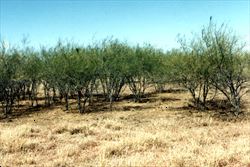
infestation (Photo: Land Protection, QDNRW)

habit of mature tree (Photo: Land Protection, QDNRW)
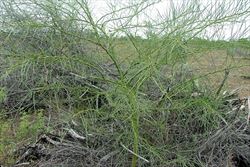
habit of younger tree (Photo: Sheldon Navie)
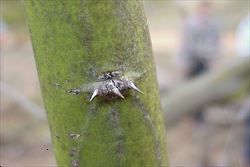
greenish-coloured older stem with thorns (Photo: Sheldon Navie)
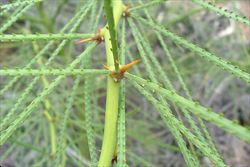
thorns and leaves on younger stem (Photo: Sheldon Navie)
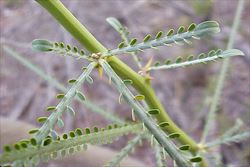
close-up of small leaflets on the strap-like leaves (Photo: Sheldon Navie)
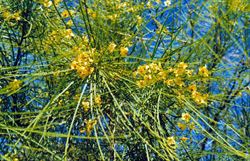
flower clusters and leaves (Photo: Land Protection, QDNRW)
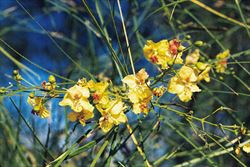
flowers (Photo: Land Protection, QDNRW)
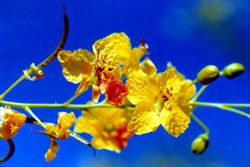
close-up of flowers and young fruit (Photo: Land Protection, QDNRW)
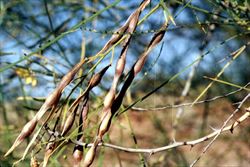
mature fruit (Photo: Land Protection, QDNRW)
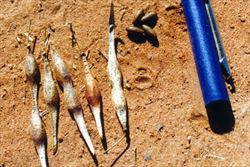
mature fruit and seeds (Photo: Land Protection, QDNRW)
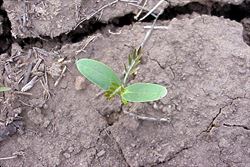
seedling (Photo: Sheldon Navie)
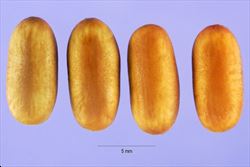
close-up of seeds (Photo: Steve Hurst at USDA PLANTS Database)
Scientific Name
Parkinsonia aculeata L.
Family
Caesalpiniaceae (Queensland, the ACT, Victoria, Tasmania, Western Australia and the Northern Territory) Fabaceae: sub-family Caesalpinioideae (New South Wales)Leguminosae (South Australia)
Common Names
Barbados flower-fence, horse bean, horse-bean, horsebean, jelly bean tree, Jerusalem thorn, Mexican palo verde, Mexican paloverde, palo verde, parkinsonia, retaima, sessaban
Origin
Native to southern USA (i.e. Texas and Arizona), northern Mexico, the Galapagos Islands and northern South America (i.e. Bolivia, Peru, Paraguay, Uruguay and northern Argentina).
Naturalised Distribution
This species is scattered throughout most of northern and central Australia, except for the wettest and most arid locations. It is particularly troublesome in inland central and northern Queensland, and in the northern parts of Western Australia and the Northern Territory. Also present in the southern parts of these states, as well as in the inland parts of northern New South Wales and some parts of South Australia.
Also naturalised overseas in tropical and southern Africa, Pakistan, Oceania (i.e. Hawaii and New Caledonia), and beyond its native range in the USA, Central America and Southern America.
Habitat
Parkinsonia (Parkinsonia aculeata) is mostly found growing near creeks, rivers and man-made water points (i.e. bores and dams) in semi-arid regions (especially those that have a distinctive wet and dry season). It is also found in tropical and sub-tropical environments and inhabits grasslands, open woodlands, rangelands, pastures, waste areas, disturbed sites and roadsides.
Habit
An upright (i.e. erect) spiny shrub or small tree often forming dense thickets. It can reach up to 10 m tall, but usually grows 2-6 m in height.
Distinguishing Features
- a shrub or small tree with green zig-zagging branches.
- its long, strap-like, compound or twice-compound leaves initially have large numbers of tiny oval leaflets.
- these leaves are drooping in nature and have a pair of spines (5-20 mm long) at their bases.
- its bright yellow flowers (2-3 cm across) have five petals and are arranged in loose elongated clusters.
- its pale brown, elongated, pods are swollen around each of the seeds.
Stems and Leaves
The branches are green in colour, hairless (i.e. glabrous), and are often drooping (i.e. pendulous) or have a zig-zagging appearance. Younger stems have a pair of sharp spines (3-20 mm long) below each leaf (i.e. stipular spines) and these remain on older stems after the leaves have been shed.
Younger plants have compound (i.e. pinnate) leaves, but as the plant grows they become twice-compound (i.e. bi-pinnate) in nature. These leaves are alternately arranged along the stems, shortly stalked or almost sessile (i.e. petiolate or sub-sessile), and drooping (i.e. pendulous) in nature. Each of the twice-compound (i.e. bi-pinnate) leaves is divided into one to three pairs of long (20-40 cm), flattened, strap-like branchlets (i.e. pinnae). Numerous small, hairless (i.e. glabrous), leaflets (i.e. pinnules) are borne along these branchlets (i.e. pinnae). These leaflets (1-10 mm long and 1-2 mm wide, but mostly only 1-4 mm long) are oblong in shape and are readily shed (i.e. caducous) leaving only the long, green, drooping branchlets remaining on the plant.
Flowers and Fruit
The flowers (2-3 cm across) are arranged in loose elongated clusters (5-20 cm long) arising from the leaf forks (i.e. in axillary racemes). Each of these flower clusters usually contains 8-17 flowers, but the flowers can occasionally be borne singly. The flowers are bright yellow in colour, sometimes with a hint of orange or red in the centre, and are borne on slender stalks (i.e. pedicels) 5-20 mm long. They have five reddish-yellow sepals (4-8 mm long) that are fused together at the base (i.e. into a calyx tube), five petals (6-18 mm long) and ten stamens (about 6 mm long). Flowering occurs mostly during winter and spring, but larger trees may flower throughout the year.
The fruit is an elongated pod that is swollen around each of the seeds (i.e. they are torulose). These pods (3-13 cm long and 5-10 mm wide) turn a light brown or straw colour when mature and usually contain 1-6 seeds (occasionally up to eight seeds). The relatively large seeds (9-15 mm long and 3-6 mm wide) are olive green to brownish in colour and are sometimes mottled. They are hard, smooth in texture, and somewhat oval (i.e. ellipsoid-ovoid) or oblong in shape.
Reproduction and Dispersal
This plant reproduces mainly by seed, but it can also produce suckers (particularly after it has been damaged).
The seeds are mostly spread after being eaten by birds and other animals (e.g. cattle). The pods also float in water and the seeds can be dispersed in mud that becomes attached to animals and vehicles.
Environmental Impact
Parkinsonia (Parkinsonia aculeata) is regarded as a significant environmental weed in Queensland, the Northern Territory and Western Australia, and as an environmental weed in New South Wales and South Australia. It is one of the 20 Weeds of National Significance (WoNS), and is actively managed by community groups in Queensland and the Northern Territory.
Legislation
This species is declared under legislation in the following states and territories:
- ACT: C4 - prohibited - a pest plant whose supply is prohibited in the ACT.
- New South Wales: Class 2 - a regionally prohibited weed. The presence of the weed must be notified to the local control authority and it must be eradicated from the land and the land must be kept free of the plant (in a large number of local authority areas). See the New South Wales Department of Primary Industries Noxious Weeds List at http://www.dpi.nsw.gov.au for more detailed information on which local areas are covered in these declarations.
- Northern Territory: B - growth and spread to be controlled (throughout all of the Territory), and C - not to be introduced into the Territory.
- Queensland: Queensland: Class 2 - landowners must take all reasonable steps to keep land free of this species (throughout the entire state). It is also illegal to sell a declared plant or its seed in this state.
- South Australia: 1N# - this species is declared in Class 1c(ii), a classification for prohibited terrestrial plants. The presence of this species must be notified and it must be destroyed (throughout the entire state).
- Tasmania: D - the importation or sale of this species is prohibited and measures to reduce its population in an area, eradicate it from an area, or restrict it to a particular area may be required.
- Victoria: R - a restricted weed that cannot be sold or traded in this state.
- Western Australia: P1 - trade, sale or movement prevented (in that part of the state north of the 26th parallel of latitude), P2 - to be eradicated (in the Ashburton, Carnarvon, Coolgardie, Cue, Dundas, East Pilbara, Exmouth, the City of Kalgoorlie-Boulder, Leonora, Laverton, Meekatharra, Menzies, Mt Magnet, Murchison, Ngaanyatjarraku, Port Hedland, Roebourne, Sandstone, Shark Bay, Upper Gascoyne, Wiluna and Yalgoo local authority areas), and P4 - infestations to be contained (in the Broome, Derby-West Kimberley, Halls Creek and Wyndham-East Kimberley local authority areas).
Management
For information on the management of this species see the following resources:
- the National Weeds Strategy Strategic Plan for this species, which is available online at http://www.weeds.org.au/docs/parstrat.pdf.
- the Parkinsonia National Case Studies Manual, which is available online at http://www.weeds.org.au/WoNS/Parkinsonia/.
- the Biosecurity Queensland Fact Sheet on this species, which is available online at http://www.dpi.qld.gov.au.
- the Northern Territory Department of Natural Resources, Environment and The Arts Agnote on this species, which is available online at http://www.nt.gov.au/weeds.
Similar Species
Parkinsonia (Parkinsonia aculeata) can be confused with several other thorny bushes, including prickly acacia (Acacia nilotica subsp. indica), mimosa bush (Acacia farnesiana) and the mesquites (Prosopis spp.). These species are all relatively common and widespread, and all have spines, compound leaves, yellow flowers and elongated seed pods. However, they can be distinguished by the following differences:
- parkinsonia (Parkinsonia aculeata) is a thorny plant with compound (i.e. pinnate) or twice-compound (i.e. bi-pinnate) leaves having few (1-3) pairs of strap-like branchlets. Its bright yellow flowers (about 2 cm across) have five petals and are borne in loose elongated clusters (i.e. racemes). The large fruit are somewhat elongated in shape (3-13 cm long and about 7 mm wide), almost cylindrical, strongly constricted between the seeds (i.e. torulose), hairless (i.e. glabrous), and turn light brown as they mature.
- prickly acacia (Acacia nilotica subsp. indica ) is a thorny plant with twice-compound (i.e. bi-pinnate) leaves having several to numerous (3-10) pairs of branchlets. Its fluffy bright yellow flowers are borne in small globular clusters (10-12 mm across) in the leaf forks. The large fruit are elongated in shape (6-25 cm long and 4-17 mm wide), somewhat flattened, softly hairy (i.e. pubescent), strongly constricted between the seeds (i.e. torulose), and turn greyish-green as they mature.
- mimosa bush (Acacia farnesiana ) is a thorny plant with twice-compound (i.e. bi-pinnate) leaves having few (2-4) pairs of branchlets. Its fluffy bright yellow flowers are borne in small globular clusters (11-15 mm across) in the leaf forks. The large fruit are somewhat elongated in shape (5-7 cm x 12-15 mm in size), almost cylindrical, often slightly curved, hairless (i.e. glabrous), and turn dark brown as they mature.
- the mesquites (Prosopis spp.) are thorny plants with twice-compound (i.e. bi-pinnate) leaves having few (1-5) pairs of branchlets. Its fluffy pale yellow, yellow, greenish-yellow or whitish coloured flowers are borne in dense elongated clusters (5-14 cm long) in the leaf forks. The large fruit are very elongated in shape (8-20 cm long and 7-15 mm wide), almost cylindrical, have slight constrictions between each of the seeds, and turn yellowish as they mature.
See the Queensland Department of Natural Resources and Water pest fact sheet on Identification of Prickle Bushes at www.nrm.qld.gov.au for more information on distinguishing between these species.

